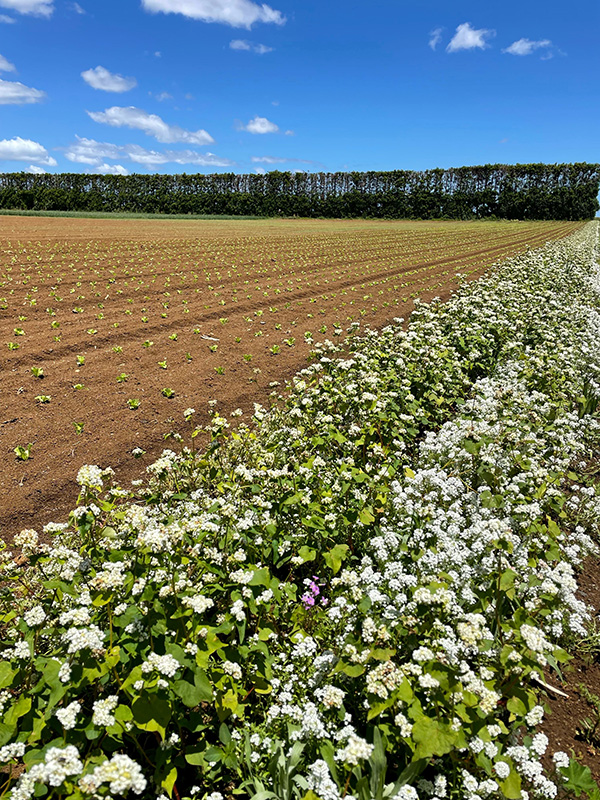Rows of blooming flowers may seem like unusual bedfellows for vegetable crops, but a project in Pukekohe is demonstrating they can be an effective tool in a grower’s pest management system.
A Vegetables NZ project with A Lighter Touch has seen single beds of cornflower, alyssum and buckwheat planted alongside vegetable crops at the Pukekohe demonstration farm. It is designed to show manipulation of plant diversity on a farm can increase beneficial insect numbers and reduce the pests in a crop, meaning less use of insecticides is required.
It’s also working through the practicalities of how incorporating beneficial insect attracting plants works in a cropping farm system. The aim is to provide growers with a resource demonstrating how they can increase biodiversity to provide a source of shelter, nectar, alternative food and pollen (SNAP) to attract and retain beneficial insects.

Temporary flower bed at the Pukekohe demonstration farm showing the end of the staggered flowering with the cornflowers. Pumpkin crop to the left and barley crop to the right. Photo credit Olivia Prouse.
The project drew on research in Australia looking at beneficial insects in brassica crops, where studies found beneficial insects move about 15 metres from the flowerbeds. By planting a single row of annual flowers 30 metres apart throughout the crop, parasitism of the diamondback moth doubled.
Planting at the Pukekohe demonstration farm started in October 2022, with a staggered flowering from November to March, starting with buckwheat, followed by alyssum, with cornflower the last species to flower.
While the project seemed straight-forward at the outset, there have been challenges to work through. A higher seed rate was required than the rate used in the Australian project because the high weed bank in the soil at Pukekohe meant the weeds were growing faster than the annuals, impacting on germination.
Residual herbicide from previous crops negatively impacted on the growth of the flower beds, and the site has nut grass and oxalis present, meaning the floral mat needed to grow up and out quickly to create shade and keep the weeds under control.
Future improvements are planned for the project including increasing the diversity of flowers to attract a wider range of beneficial insects. Also under consideration is trap cropping with yellow rocket to reduce diamondback moth numbers, and improving soil health by sowing cover crops of a mixture of annual flowers, rather than leaving soil fallow after cropping.

Temporary flower bed at the Pukekohe demonstration farm showing the end of the staggered flowering with the cornflowers. Pumpkin crop to the left and barley crop to the right. Photo credit Olivia Prouse.
Those working on the project recognise not all growers want to plant whole beds of annual flowers, and are investigating moveable pods as an alternative method of using beneficial planting. The wicking pods planted with flowering natives could be moved by a tractor, enabling them to be used as and when required on the different crops on farm.
For example, onions require multiple herbicide applications when first planted, but the insect pest threat at that time is low. Moveable pods could be transported into the onion crop once the herbicide applications are complete and the insect pressure starts, which the floral resource in the pods could help control.
It’s not just about proving beneficials work, it’s also about providing options and developing solutions to enable growers to successfully make the move to using beneficial planting in their farming operations.
Learn more about this project as it progresses in the Our Projects section of our website.
If you are interested in knowing more about the A Lighter Touch programme, subscribe to our newsletter In Touch by clicking this link.
